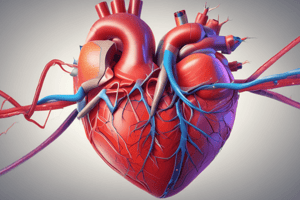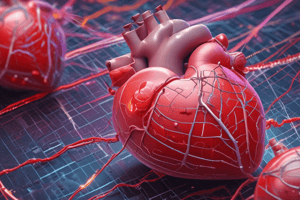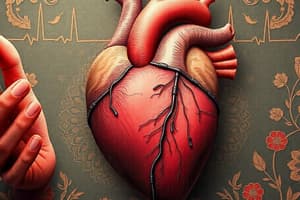Podcast
Questions and Answers
Which of the following scenarios would typically result in the lowest heart rate?
Which of the following scenarios would typically result in the lowest heart rate?
- A female jogging.
- A male athlete sleeping. (correct)
- A 6-year-old child watching television.
- A female doing yoga.
The basal level of heart rate under normal resting conditions is typically in which range?
The basal level of heart rate under normal resting conditions is typically in which range?
- 30-40 beats/min
- 70-80 beats/min (correct)
- 50-60 beats/min
- 90-100 beats/min
A doctor measures a patient's resting heart rate at 95 beats per minute. Which of the following could explain this elevated heart rate?
A doctor measures a patient's resting heart rate at 95 beats per minute. Which of the following could explain this elevated heart rate?
- The patient is an adult male.
- The patient is a young child. (correct)
- The patient is sleeping.
- The patient is a male athlete.
Which of the following factors generally contributes to a lower heart rate?
Which of the following factors generally contributes to a lower heart rate?
Which factor will cause an increase in the heart rate?
Which factor will cause an increase in the heart rate?
Why is ventricular fibrillation considered a rapidly fatal condition?
Why is ventricular fibrillation considered a rapidly fatal condition?
What ventricular contraction rate is typically associated with ventricular fibrillation?
What ventricular contraction rate is typically associated with ventricular fibrillation?
In the context of heart function, what is the primary consequence of ventricular fibrillation?
In the context of heart function, what is the primary consequence of ventricular fibrillation?
Which physiological process is most directly disrupted by atrioventricular block?
Which physiological process is most directly disrupted by atrioventricular block?
What is a key difference between ventricular fibrillation and atrioventricular block in terms of their primary effect on heart function?
What is a key difference between ventricular fibrillation and atrioventricular block in terms of their primary effect on heart function?
What is the most likely effect of hypercalcemia on the heart's function?
What is the most likely effect of hypercalcemia on the heart's function?
A patient's blood test reveals hyperkalemia. Which of the following is the most likely consequence regarding heart function?
A patient's blood test reveals hyperkalemia. Which of the following is the most likely consequence regarding heart function?
Which of the following best illustrates a positive inotropic effect on the heart?
Which of the following best illustrates a positive inotropic effect on the heart?
If a patient is administered digitalis, what change in cardiac function would be expected, and why?
If a patient is administered digitalis, what change in cardiac function would be expected, and why?
A patient with a known heart condition experiences a sudden increase in blood calcium levels. Which intervention would be MOST appropriate given the effects of hypercalcemia?
A patient with a known heart condition experiences a sudden increase in blood calcium levels. Which intervention would be MOST appropriate given the effects of hypercalcemia?
If total peripheral resistance remains constant, which of the following changes would directly lead to an increase in arterial blood pressure (ABP)?
If total peripheral resistance remains constant, which of the following changes would directly lead to an increase in arterial blood pressure (ABP)?
A patient's arterial blood pressure (ABP) increases significantly. Assuming no changes in total peripheral resistance, what change in cardiac output (COP) is most likely responsible for this increase in ABP?
A patient's arterial blood pressure (ABP) increases significantly. Assuming no changes in total peripheral resistance, what change in cardiac output (COP) is most likely responsible for this increase in ABP?
In a scenario where a patient's cardiac output (COP) is reduced by 20% due to a sudden heart condition, what compensatory mechanism involving total peripheral resistance would help maintain arterial blood pressure (ABP)?
In a scenario where a patient's cardiac output (COP) is reduced by 20% due to a sudden heart condition, what compensatory mechanism involving total peripheral resistance would help maintain arterial blood pressure (ABP)?
A doctor administers a drug that doubles a patient's cardiac output (COP) but observes only a slight increase in arterial blood pressure (ABP). Which of the following is the most likely explanation for this?
A doctor administers a drug that doubles a patient's cardiac output (COP) but observes only a slight increase in arterial blood pressure (ABP). Which of the following is the most likely explanation for this?
During intense exercise, both cardiac output (COP) and total peripheral resistance change. If COP increases significantly, what change in total peripheral resistance is most likely to occur and why?
During intense exercise, both cardiac output (COP) and total peripheral resistance change. If COP increases significantly, what change in total peripheral resistance is most likely to occur and why?
What is the primary relationship between arterial blood pressure (ABP) and coronary blood flow?
What is the primary relationship between arterial blood pressure (ABP) and coronary blood flow?
How does sympathetic stimulation affect coronary blood vessels?
How does sympathetic stimulation affect coronary blood vessels?
Which of the following best describes the effect of parasympathetic stimulation on coronary blood vessels?
Which of the following best describes the effect of parasympathetic stimulation on coronary blood vessels?
If a patient's diastolic blood pressure decreases significantly, what direct effect would this have on coronary blood flow, assuming other factors remain constant?
If a patient's diastolic blood pressure decreases significantly, what direct effect would this have on coronary blood flow, assuming other factors remain constant?
A medication that blocks sympathetic nervous system activity is administered. What change in the coronary blood vessels would be expected as a direct result?
A medication that blocks sympathetic nervous system activity is administered. What change in the coronary blood vessels would be expected as a direct result?
How does increased sympathetic nerve activity contribute to physiological changes in individuals with increased adipose tissue?
How does increased sympathetic nerve activity contribute to physiological changes in individuals with increased adipose tissue?
What is the combined effect of increased aldosterone and angiotensin II levels on blood pressure in obese individuals?
What is the combined effect of increased aldosterone and angiotensin II levels on blood pressure in obese individuals?
How does leptin, released from adipose tissue, influence sympathetic nerve activity?
How does leptin, released from adipose tissue, influence sympathetic nerve activity?
Why might increased levels of aldosterone and angiotensin II be observed in obese individuals?
Why might increased levels of aldosterone and angiotensin II be observed in obese individuals?
What is the likely long-term effect of chronically increased sympathetic nerve activity, aldosterone, and angiotensin II levels in an individual with obesity?
What is the likely long-term effect of chronically increased sympathetic nerve activity, aldosterone, and angiotensin II levels in an individual with obesity?
Flashcards
Hypercalcemia effect on heart
Hypercalcemia effect on heart
High blood calcium levels, leading to prolonged systole and potential spastic contraction (calcium rigor).
Hyperkalemia effect on heart
Hyperkalemia effect on heart
High blood potassium levels, leading to prolonged diastole, causing a dilated and flaccid heart.
Inotropism
Inotropism
Influence on the force of heart contraction.
Positive Inotropic Factor
Positive Inotropic Factor
Signup and view all the flashcards
Digitalis
Digitalis
Signup and view all the flashcards
What is Heart Rate (HR)?
What is Heart Rate (HR)?
Signup and view all the flashcards
Normal resting heart rate
Normal resting heart rate
Signup and view all the flashcards
When is HR higher?
When is HR higher?
Signup and view all the flashcards
When is HR lower?
When is HR lower?
Signup and view all the flashcards
Heart rate under normal resting conditions
Heart rate under normal resting conditions
Signup and view all the flashcards
Ventricular Fibrillation (VF)
Ventricular Fibrillation (VF)
Signup and view all the flashcards
VF Consequences
VF Consequences
Signup and view all the flashcards
Abnormal Conductivity Arrhythmias
Abnormal Conductivity Arrhythmias
Signup and view all the flashcards
Atrio-Ventricular (A-V) Block
Atrio-Ventricular (A-V) Block
Signup and view all the flashcards
Impact of A-V Block
Impact of A-V Block
Signup and view all the flashcards
What is Leptin?
What is Leptin?
Signup and view all the flashcards
Increased sympathetic nerve activity
Increased sympathetic nerve activity
Signup and view all the flashcards
Increased heart rate and blood pressure
Increased heart rate and blood pressure
Signup and view all the flashcards
Aldosterone and Angiotensin II
Aldosterone and Angiotensin II
Signup and view all the flashcards
Increased aldosterone & angiotensin II
Increased aldosterone & angiotensin II
Signup and view all the flashcards
ABP equation
ABP equation
Signup and view all the flashcards
Arterial Blood Pressure (ABP)
Arterial Blood Pressure (ABP)
Signup and view all the flashcards
Coronary Blood Flow
Coronary Blood Flow
Signup and view all the flashcards
Cardiac Output (CO)
Cardiac Output (CO)
Signup and view all the flashcards
Diastolic Blood Pressure
Diastolic Blood Pressure
Signup and view all the flashcards
CO and ABP relationship
CO and ABP relationship
Signup and view all the flashcards
Total Peripheral Resistance (TPR)
Total Peripheral Resistance (TPR)
Signup and view all the flashcards
Sympathetic Stimulation
Sympathetic Stimulation
Signup and view all the flashcards
Parasympathetic Stimulation
Parasympathetic Stimulation
Signup and view all the flashcards
TPR and ABP relationship
TPR and ABP relationship
Signup and view all the flashcards




